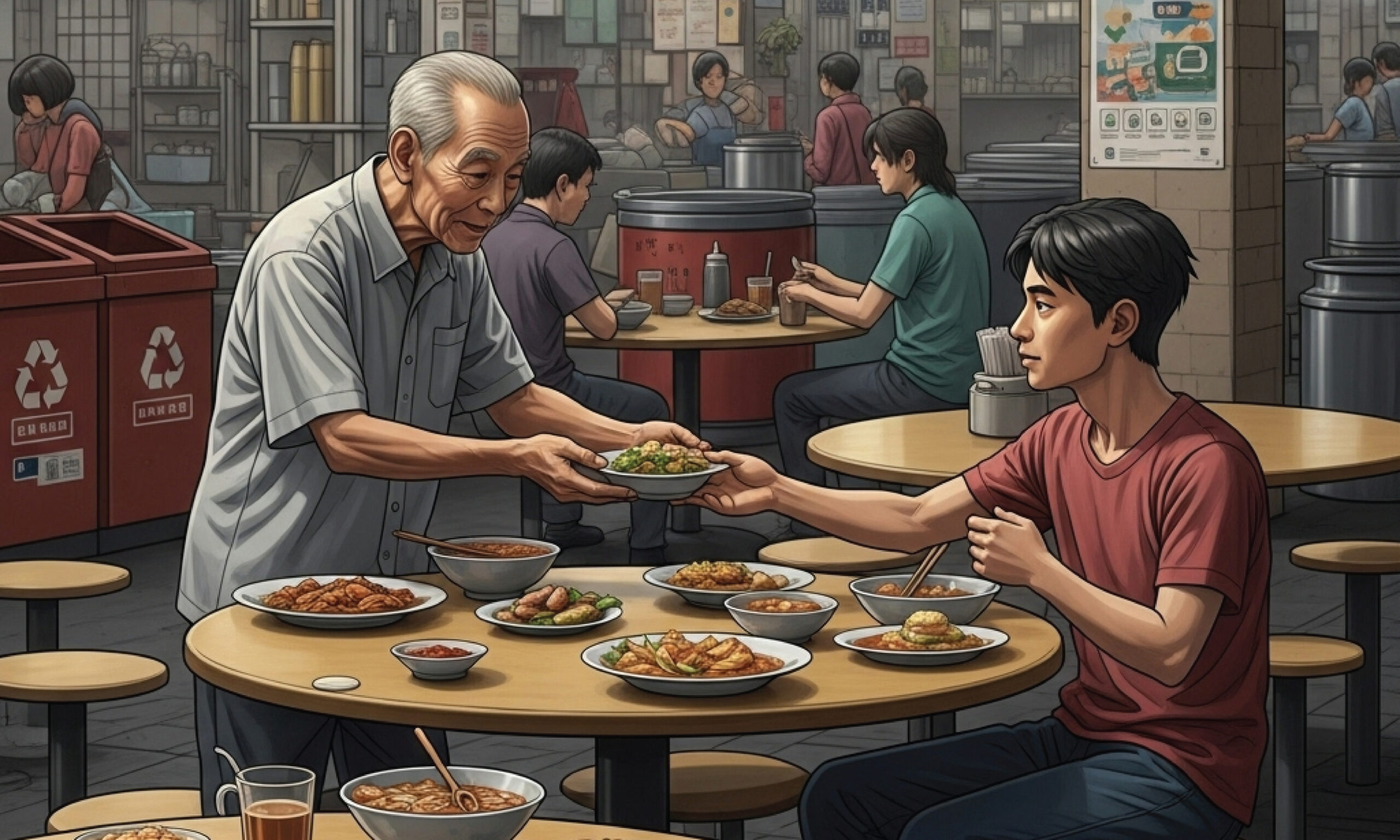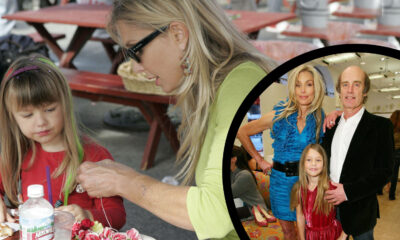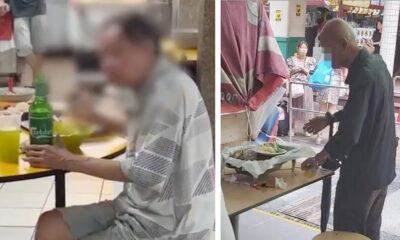Food
Food Waste or Free Meal? The Truth About Chinatown Hawker Leftovers Consumption

- Share
- Tweet /home/u433845138/domains/newsmm.co.uk/public_html/wp-content/plugins/mvp-social-buttons/mvp-social-buttons.php on line 71
https://newsmm.co.uk/wp-content/uploads/2025/06/bdfbb-01-1000x600.jpg&description=Food Waste or Free Meal? The Truth About Chinatown Hawker Leftovers Consumption', 'pinterestShare', 'width=750,height=350'); return false;" title="Pin This Post">
Walk into any bustling Chinatown hawker center, be it in Singapore, Malaysia, or even beyond, and you’re immediately hit by a symphony of sizzles, clangs, and the intoxicating aroma of diverse cuisines. These vibrant food hubs are cornerstones of culture, community, and, undeniably, incredible food. But once the last patron has left, and the tables are cleared, a less talked about aspect emerges: the fate of the leftovers.
For many, “leftovers” conjure images of home-cooked meals neatly packed for tomorrow’s lunch. However, in the public domain of a hawker center, the concept takes on a different, more complex meaning. Is a plate of unfinished char kway teow merely food waste destined for the bin, or could it, in some circumstances, become a “free meal” for someone in need or someone committed to zero waste? This article delves deep into the intriguing world of Chinatown hawker leftovers consumption, exploring the practices, the inherent risks, the regulatory frameworks, and the broader societal push towards food waste reduction.
The Unseen Practice: Who Consumes Leftovers and Why?
It might come as a surprise to some, but the consumption of leftovers from public dining spaces isn’t entirely unheard of. While not a widespread practice, there are specific contexts and reasons behind it.
In certain parts of Southeast Asia, particularly Singapore’s older hawker centers like People’s Park Food Centre in Chinatown, there have been observations of elderly individuals partaking in what others have left behind. It’s crucial to understand the nuances here. Often, it’s not solely driven by destitution or an inability to afford a meal. For some, it stems from a deep-seated belief in not wasting food – a virtue passed down through generations. The logic often is: the food is still warm, it looks edible, and it’s better consumed than discarded. This perspective often clashes with modern food safety guidelines but highlights a deeply ingrained cultural value of frugality and respect for resources.
Beyond this more traditional perspective, there’s also the “freegan” movement. Originating from “free” and “veganism” (though not always strictly vegan in practice), freegans are individuals who seek to reduce their environmental footprint and protest consumerism by salvaging discarded goods, including food. While the primary method of food sourcing for freegans might involve “dumpster diving” from supermarkets, some might consider public leftovers. However, even within this community, there’s a significant emphasis on caution. The preferred approach, if considering public food, is to politely ask diners who are still at their tables if they intend to finish their food. This ensures the food is still fresh and hasn’t been exposed to the elements or potential contamination for an extended period. The principle here is to prioritize food that is clearly still good and safe, avoiding the inherent risks of truly “discarded” items.
It’s a fascinating intersection of economic realities, cultural values, and a growing environmental consciousness. But regardless of the motivation, the act itself immediately raises a critical question: is it safe?
The Elephant in the Room: Food Safety Concerns
When it comes to consuming food that has been left unattended in a public setting, food safety becomes the paramount concern. The risks are substantial and cannot be overstated.
The primary culprit behind foodborne illnesses is the rapid multiplication of bacteria. Food, especially cooked food, is most vulnerable when it sits in the “temperature danger zone,” which is generally between 5°C and 60°C (40°F to 140°F). In this temperature range, harmful bacteria like Salmonella, E. coli, and Listeria can double in number every 20 minutes. Food left out for more than two hours – and certainly beyond four hours – in this zone can become a breeding ground for these microorganisms, making it unsafe to consume.
Consider the journey of a hawker meal: it’s cooked, served, eaten, and then potentially left on a table. During this time, it’s exposed to ambient temperatures, open air, and potentially the hands of the previous diner. There’s also the risk of cross-contamination from various sources – pests like flies and cockroaches, other diners, or even unclean surfaces. You simply cannot know the health status of the previous consumer; if they were sick, their remnants could easily transmit pathogens. The potential for unpleasant symptoms like nausea, vomiting, diarrhea, and fever, or even more severe health complications, is very real.
This isn’t to demonize the act itself but to highlight the inherent dangers. From a public health perspective, the consumption of such leftovers is strongly discouraged due to the uncontrollable variables and the high potential for food poisoning.
The Guardians of Good Food: Regulatory Frameworks and Hygiene Standards
Fortunately, countries with thriving hawker cultures, such as Singapore, have robust regulatory bodies dedicated to ensuring food safety. The Singapore Food Agency (SFA) is a prime example of an organization with stringent guidelines in place to protect consumers.
Hawker centers in Singapore are far from unregulated. They are subject to continuous oversight and strict protocols designed to maintain the highest levels of hygiene. Key regulations and practices include:
- Hygiene Grade Certificates: Every hawker stall is required to prominently display its hygiene grade, ranging from ‘A’ (excellent) to ‘D’ (poor). This empowers consumers to make informed choices and encourages stalls to maintain high standards.
- Mandatory Cleaning Protocols: Hawker stalls adhere to strict cleaning schedules and protocols for their food preparation areas, cooking equipment, and utensils. This includes regular washing, sanitizing, and proper storage.
- Waste Management: Efficient and proper waste management is crucial. Rubbish bins are frequently emptied, and waste is disposed of in a manner that prevents pest infestation and contamination.
- Personal Hygiene of Vendors: Food handlers are required to maintain impeccable personal hygiene, including wearing clean attire, tying up hair, and frequent handwashing.
- Food Handler Training: All food handlers must complete a Basic Food Hygiene Course, equipping them with essential knowledge on safe food handling practices, temperature control, and cross-contamination prevention.
- Regular Inspections and Monitoring: SFA officers conduct regular, unannounced inspections of hawker stalls to ensure compliance with all regulations. They also conduct environmental monitoring for contaminants and take samples for laboratory analysis.
- Regulatory Limits: The SFA sets stringent regulatory limits for various substances in food, aligning with international standards, ensuring that food products are safe for consumption.
These measures are in place precisely to prevent food from becoming hazardous while it’s in the hawker center’s care. However, once food leaves the hands of the vendor and is placed on a table, the control over its safety diminishes rapidly, underscoring why consuming leftovers from strangers is a risky endeavor.
Beyond Leftovers: A Broader Push Towards Food Waste Reduction
While the consumption of hawker leftovers by individuals is a small part of the narrative, the larger, more impactful story is the global and national effort to reduce food waste. Singapore, in particular, has positioned itself as a “Zero Waste Nation” and has implemented ambitious initiatives to tackle food waste at every level.
Governmental programs are multifaceted:
- Public Awareness Campaigns: The National Environment Agency (NEA) and SFA regularly launch public awareness campaigns, such as the “Love Your Food” initiative. These campaigns educate consumers on smart shopping, proper food storage, and creative ways to utilize leftovers at home, effectively minimizing waste from the household.
- Food Donation Networks: Significant efforts are made to connect food businesses with excess edible food to food banks and charitable organizations. This ensures that surplus food, which is still safe and wholesome, reaches those in need rather than ending up in landfills.
- On-site Food Waste Recycling: Many hawker centers and large food establishments are increasingly adopting on-site food waste recycling solutions. These include food waste digesters and anaerobic digestion systems. These technologies convert food waste into valuable resources like biogas (which can be used to generate electricity) and bio-fertilizer, closing the loop on organic waste.
- Mandatory Tray Return Policy: In Singapore’s hawker centers, a mandatory tray return policy has been implemented. While primarily aimed at improving cleanliness and reducing the workload of cleaners, it also subtly highlights the amount of food left on trays, serving as a visual reminder of food waste.
Beyond government efforts, various ground-up initiatives and social enterprises are making a significant impact:
- Freegan Networks (Responsible Practices): While some freegans might consider certain public leftovers, many networks focus on responsible practices like collecting discarded but still perfectly edible produce from markets or surplus baked goods from bakeries, often with permission.
- Community Refrigerators: The concept of “community fridges” or “open access” refrigerators is gaining traction. Residents can deposit their excess, edible food items into these publicly accessible fridges for anyone to take, creating a localized food sharing network and preventing waste.
- Social Enterprises: Organizations like MoNo Singapore exemplify a more structured approach. They collect food items that are perfectly safe to eat but are approaching their “best before” dates from retailers and redistribute them through a “pay-as-you-wish” model. This combats food waste while also addressing food insecurity.
Furthermore, technology is playing an increasingly vital role in modern food waste management within hawker centers:
- Smart Bins: Equipped with sensors and weighing scales, smart bins can record data on segregated food waste, providing valuable insights into waste patterns and volumes.
- Automated Data Analytics: This data can be analyzed to identify trends, pinpoint areas of high waste, and inform targeted interventions.
- IoT Sensors and Temperature Monitoring: These technologies ensure that food storage areas maintain optimal temperatures, reducing spoilage and enhancing overall food safety throughout the supply chain.
Conclusion: A Balancing Act
The phenomenon of Chinatown hawker leftovers consumption is a microcosm of larger societal issues: food waste, food insecurity, and the constant push-and-pull between cultural practices and modern food safety standards. While the act of consuming unknown leftovers carries significant health risks and is strongly discouraged by public health authorities, it simultaneously sheds light on deeply ingrained values of frugality and a growing awareness of food waste.
10 Frequently Asked Questions (FAQs) about Chinatown Hawker Leftovers Consumption
1. Is it safe to eat leftovers from a Chinatown hawker stall that someone else left behind? No, it is generally not safe to eat leftovers from a hawker stall that someone else has left behind. The primary risk is foodborne illness, as bacteria can multiply rapidly in food left at room temperature. You also don’t know how long the food has been out or if it’s been contaminated by the previous diner or pests.
2. Why do some people still consume hawker leftovers, despite the risks? Reasons vary, but often include a strong personal belief in reducing food waste, a desire to salvage edible food (as in the “freegan” movement), or, in some cases, economic hardship, though this is less common than the anti-waste motivation in publicly observed instances.
3. What are the main dangers of eating public leftovers? The main dangers include food poisoning from bacteria like Salmonella or E. coli that grow in the “temperature danger zone.” There’s also a risk of cross-contamination from unhygienic conditions, pests, or even from the previous diner if they were unwell.
4. How long can cooked food safely sit out at room temperature? Cooked food should not be left out at room temperature for more than two hours. After four hours, it becomes significantly riskier and should be discarded, regardless of how it looks or smells.
5. How do authorities like the Singapore Food Agency (SFA) ensure food safety in hawker centers? The SFA has stringent regulations. They require hawker stalls to display hygiene grades, enforce strict cleaning protocols, mandate food handler training, conduct regular inspections, and monitor for contaminants to ensure high food safety standards.
6. What are hawker centers doing to reduce food waste? Hawker centers are implementing various strategies, including on-site food waste recycling systems (like digesters), encouraging customers to return trays (which helps visualize waste), and participating in broader national food waste reduction initiatives.
7. Are there organized efforts to “rescue” edible food from hawker centers that would otherwise be thrown away? Yes, while direct “leftovers” from plates are risky, there are organized efforts and social enterprises that work with hawkers to collect surplus, unsold food that is still perfectly safe and redistribute it to those in need, thereby preventing waste.
8. What should I do if I see someone consuming potentially unsafe leftovers in a public area? It’s a delicate situation. You could gently and respectfully try to inform them about the food safety risks. However, directly intervening can be challenging. Reporting to authorities is usually not necessary unless there’s a clear public health hazard being created by the hawker itself.
9. How can I help reduce food waste in hawker centers? You can help by:
- Ordering only what you can finish.
- Asking for smaller portions if available.
- Returning your tray and utensils (if required).
- Supporting hawkers who participate in food donation or recycling programs.
10. What are some general tips for safely handling leftovers at home? Always refrigerate cooked food promptly (within two hours), consume it within 2-3 days, and reheat it thoroughly to at least 70°C (158°F) before eating. Avoid reheating food more than once. If in doubt, throw it out!
Click for more amazing info. News MM

-

 Celebrity8 months ago
Celebrity8 months agoIndia Rose Brittenham: All You Need to Know About Heather Thomas’ Daughter
-

 Celebrity8 months ago
Celebrity8 months agoMargot Rooker: All You Need to Know About Michael Rooker’s Wife
-

 Celebrity8 months ago
Celebrity8 months agoNadia Farmiga? All You Need to Know About Taissa Farmiga’s Sister
-

 Celebrity8 months ago
Celebrity8 months agoRobert Noah? All You Need to Know About Trevor Noah’s Father
-

 Celebrity8 months ago
Celebrity8 months agoJackie Witte? All You Need to Know About Paul Newman’s First Wife
-

 Celebrity8 months ago
Celebrity8 months agoCheryl Pistono? All You Need to Know About Kareem Abdul-Jabbar’s Ex-Girlfriend
-

 Celebrity8 months ago
Celebrity8 months agoAbigail S. Koppel? All You Need to Know About Leslie Wexner’s Wife
-

 Celebrity7 months ago
Celebrity7 months agoWho is the Father of Jay-Z? Biography of Adnis Reeves














